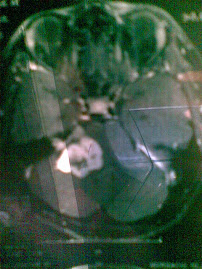An acoustic neuroma (sometimes termed a vestibular schwannoma or neurolemmoma) is a benign (non-cancerous) growth that arises on the eighth cranial nerve leading from the brain to the inner ear. This nerve has two distinct parts, one part associated with transmitting sound and the other with sending balance information to the brain from the inner ear. The eighth nerve, along with the facial or seventh cranial nerve, lie adjacent to each other as they pass through a bony canal called the internal auditory canal. This canal is approximately 2 cm (0.8 inches) long and it is generally here that acoustic neuromas originate from the sheath surrounding the eighth nerve. The seventh or facial nerve provides motion to the muscles of facial expression.
| Small Acoustic Neuroma | Medium Acoustic Neuroma | Large Acoustic Neuroma |
Acoustic neuromas usually grow slowly over a period of years. They expand in size at their site of origin and when large can displace normal brain tissue. The brain is not invaded by the tumor, but the tumor pushes the brain as it enlarges. The slowly enlarging tumor protrudes from the internal auditory canal into an area behind the temporal bone called the cerebellopontine angle. The tumor now assumes a pear shape with the small end in the internal auditory canal. Larger tumors can press on another nerve in the area (the trigeminal nerve) which is the nerve of facial sensation. Vital functions to sustain life can be threatened when large tumors cause severe pressure on the brainstem and cerebellum. Tumors are typically described as small (less than 1.5 cm), medium (1.5 cm to 2.5 cm) or large (more than 2.5 cm).
Are Acoustic Neuromas hereditary?
No. Although there is an inheritable condition called neurofibromatosis type 2 which can lead to acoustic neuroma formation in some people, most acoustic neuromas occur spontaneously without any evidence of an inheritable pattern.
How often do Acoustic Neuromas occur?
Most recent publications suggest that the incidence of acoustic neuromas is rising. This is because of advances in MRI scanning both on incidental scans and for patients experiencing symptoms. Studies in Denmark published in 2004 show the incidence is 17.4 per million or close to 2 persons per 100,000. Most acoustic neuromas are diagnosed in patients between the ages of 30 and 60.
Cause or Etiology of Acoustic Neuroma
Many patients inquire about the cause of the tumor. There is a growing body of evidence that sporadic defects in tumor suppressor genes may give rise to these tumors in some individuals. Other studies have hinted at exposure to loud noise on a consistent basis. One study has shown a relationship of acoustic neuromas to prior exposure to head and neck radiation, and a concomitant history of having had a parathyroid adenoma (tumor found in proximity to the thyroid gland controlling calcium metabolism). There are even controversies on hand held cellular phones. Whether or not the radiofrequency radiation has anything to do with acoustic neuroma formation, remains to be seen. To date, no environmental factor (such as cell phones and diet) has been scientifically proven to cause these tumors.
from http://www.anausa.org

.jpg)

No comments:
Post a Comment